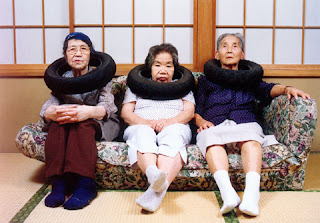Small Mama & Big Shoes, 1997/2007
"Tire Tube Communication: Mama and Neighbours"
1996/2007
1996/2007
Images are all taken from the website of the DNA Gallery which is here.
I am not quite convinced by the argument, which jo urged on us today, that these images of his elderly mother are acceptable. I think it is somewhat intrusive to use her images in this way, because even if orimoto himself takes them lovingly,they are open to interpretation as abusive and manipulative of a person who probably has little choice.
I am not sure any of this work is try convincing, actually. What is Orimoto really trying to say? Is any of this "art"? Or is he just making some rather odd and sometimes amusing photographic images? Are the 'events' achieving anything meaningful other than some odd looks from passing people? The Bread Man series in particular seems to me to have no obvious point - nor is it particularly pleasing in aesthetic terms.
Or perhaps I am missing the point somewhere...
Orimoto's work is part of the ongoing Fluxus movement, which began in the 1960s in New York, and was part of the wider democratisation of art. The four principles of Fluxus are that Fluxus is an attitude, not a style; it is inter-media, it transcends the separate artistic categories, its works are simple, and are fun. Fluxus often emerges as performance art or events or 'happenings', rather than static and 'finished' pieces of viewable art of the more traditional kind, and including music, poetry and film. Another influence was Arte Povera, or Poor Art, i.e. art which used 'found' materials, which emerged in Europe, and Italy in particular, during the 1970s.
Other artists within Fluxus include Joseph Beuys, George Maciunas and Yoko Ono, and the composer John Cage. There is a helpful Guardian piece about Maciunas (1931 - 1978) here and more here about his Lithuanian background and involvment in the Fluxus in New York, from where this is copied.....
In 1948, Maciunas and his family emigrated to the USA after a brief period in Germany. At various universities there, he studied art history, graphic art, architecture, musical theory and European and Siberian Art of Migrations from 1949 to 1960. From his student days on, Maciunas was deeply interested in the systematisation of knowledge using numerous diagrams, atlases and charts.
In 1960, when Maciunas was still involved in the Lithuanian diaspora of New York, he conceived his first plans to publish a magazine called Fluxus. As from 1961, in the AG Gallery in New York that he ran together with Almus Salcius, he organised concerts with artists like Dick Higgins, Yoko Ono and Jackson Mac Low, which can be categorised as Pre- or Proto-Fluxus. In 1961, he moved to Germany (Wiesbaden) and met Emmett Williams, Nam June Paik, Ben Patterson and Wolf Vostell. In September 1962, the first series of concerts organised by MaciunasFluxus – International Festival of Newest Music took place in Wiesbaden, attracting considerable attention and unsettling the public, mainly due to the complete destruction of a concert grand piano (the performance was of the piece Piano Activities by Philip Corner). As a fervent Communist, at this time Maciunas was also committed to the union of “revolutionary-realist artists” with the “revolutionary-realist society” of the USSR as the main aim of Fluxus. However, numerous plans for travel to or even the complete transfer of the Fluxus “collective” to the former Eastern Bloc were not realised. Having returned to the USA in 1963, Maciunas continued to be the main organiser of numerous Fluxus events and the self-appointed President of Fluxus. There was serious discord within the Fluxus network in 1964, due to Maciunas’ and Henry Flynt’s protest actions against Karlheinz Stockhausen’s Originale.
Maciunas published numerous editions by the artists of the network (which he himself designed strikingly), and as from 1966, he planned the Fluxhousing Cooperative, which established Soho as an artists’ quarter. In 1975, Maciunas withdrew to New Marlborough, Massachusetts, where he died of cancer at the age of forty-six in 1978.
My feelings about some of these artists and their works is that, while purporting to be accessible, non-elitist, using found materials and simple compositions or structures, in fact they require quite a lot of interpretation before they make much sense. So they are not terribly accessible, after all. Or else they just seem bizarre, strange, a bit crazy at times. Or perhaps I am getting old and a bit set in my ways.



No comments:
Post a Comment